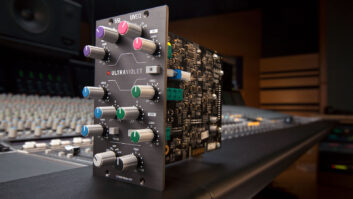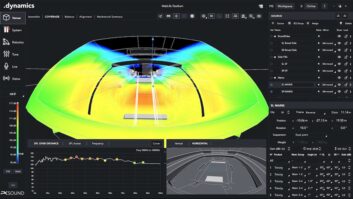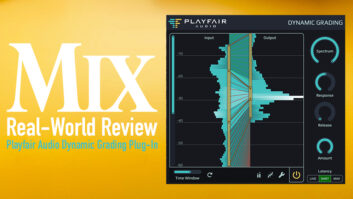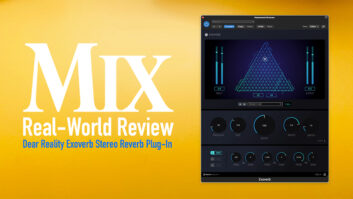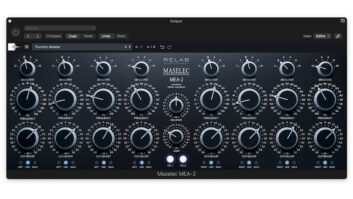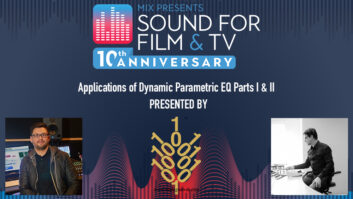The Expounder, from Scottish company CLM Dynamics, is an analog stereo/dual mono 4-band parametric equalizer with stereo high/lowpass filters that expands the traditional role of EQ with a few clever and powerful twists. Housed in a sizable (three-rackspace) chassis, the Expounder may be intimidating at first glance, but is usable immediately after a quick read of its well-written manual.
The rear panel has balanced XLR I/Os with separate +4dBu or -10dBV level switches. The front panel PPM responding LED meter has a peak holding circuit that indicates when output levels reach 0 dB or higher. With radical equalization, the unit’s internal headroom can be exceeded, and in such cases, each channel’s +/-15dB input gain controls come in handy. Also, peak LEDs on each equalizer section illuminate when levels reach +12 dBu or 12 dBu be-low clipping-another useful touch, as CLM recommends driving the Expounder “fairly hot” to maximize performance and signal-to-noise ratio. In Bypass, the output LED’s read the input level (clever) and should normally peak around +4 to +6 dB.
A Master Enable switch is a non-hard-wired/non-relayed bypass switch. When switched to Bypass, the audio signal goes through the input unbalancing circuit (two op-amps) and then an output balancing circuit (two op-amps), so the Expounder must be powered on to pass audio.
TRACKING FILTERS IN USEFor this review, I checked out the Expounder on pre-recorded mixes and on individually recorded tracks from a multitrack master. As I suspected, a first-time user (such as myself) requires some necessary “fiddly” time with this deep and comprehensive equalizer.
Each channel of the stereo Expounder has a sweepable highpass (marked Lo-Cut) filter and a lowpass (labeled Hi-Cut) filter with either 12 or 24dB/octave roll-off. These are two single pole filters in series, placed in the feedback loop of a 2108 op-amp (from THAT Corporation), with each filter providing up to 12 dB of attenuation. According to designer Allan Bradford, the phase shift is linear with frequency, and by the time the phase has shifted by 180Degrees, the attenuation has reached 35 dB below passband, and consequently, the only thing affected is the steepness of the slope, and ultimately, the amount of out-of-band rejection. But whatever the reason, I found the high and lowpass filters to be smooth, non-ringy and surprisingly full range: The highpass goes from 15 to 16k Hz while the lowpass sweeps from 75 to 24k Hz. (Check these first if you have no sound coming through the unit!)
In Expounder’s Track mode, the filters dynamically follow the amplitude of the audio source. This tracking action has a fast attack and release nature-the better to exactly “trace” the amplitude shape of your audio source. Tracking makes it possible to use a higher frequency setting (in case of a highpass rumble filter) than you would with regular, fixed highpass filters. When rolling off low frequencies (such as air conditioning or traffic rumble) or high frequencies (tape or guitar amp hiss) the filter’s action is less noticeable, as the filter “opens and closes” predicated on level and takes advantage of the psychoacoustic masking effect (when a louder sound covers up a quieter sound at the same frequency).
Using this feature extensively for electric guitar amp noise and for stage floor rumble, I found that the filter shuts like a noise gate when there is no sound. In addition, the filters each have a switchable resonance control that intro- duces a resonant peak of up to 12 dB at the selected cut-off frequency. Resonance is usually only found on synth filters; perhaps it is a holdover here from Allan Bradford’s analog synthesizer designs. Including it here makes the Expounder a one-of-a-kind box. At maximum settings, the Res control stops just short of oscillation and adds a noticeable whistle to the filter’s action. The result is difficult to describe exactly, but it reminds me of a high-quality envelope filter that tracks perfectly. This effect works wonderfully on very dynamic individual tracks such as rhythm guitars, drum loops or more frequency-coherent noises such as percussion tracks, techno or industrial type sounds.
FOUR-BAND EQUALIZERThe four band sections are labeled LF, LMF, HMF and HF. Like the two filter sections, all four sections have their own individual Enable or Bypass switch. The LMF and HMF sections are fully parametric, while LF and HF have a choice between two fixed Q’s. The bands are all overlapping, with the HF section covering almost the entire HMF section.
The LF section is continuously variable from 40 to 300 Hz. A Bell switch changes the section from a shelving EQ to a bell-shape EQ. While in Bell, the Slope button alters the bell shape from 6 to 12 dB/octave. You can boost or cut 20 dB-an enormous amount, so there is a “/3” button that divides the range by three (about +/-6 dB) for finer, more subtle control. The Dynamic switch expands the dynamic range of the frequencies selected in the LF section. Up to 5 dB of extra dynamic range is possible, with quick attack and release expansion. This effect only works for positive values or boosts of LF; I was hoping the effect could also be subtractive or inverted, so that a selected band of frequencies would be attenuated following the increased level. The Tracking mode will punch up any bass instrument or drum much differently than a regular equalizer: When I tried using only a slight boost, the Expounder emphasized the fundamental frequency of a bass guitar without woofing out the rest of the instrument’s sound.
The LMF section covers from 200 to 2k Hz. In this section, a Variable Q control changes filter shape from 0.7 to 1.5, which is not high enough Q for certain tone sculpting. However, you can boost or cut +/-15 dB or use the “/3” button for a range of +/-5 dB. The Notch button changes the entire section into a notch filter with a maximum depth of -30 dB. The Q in notch mode is not tight enough for removing very small bands of frequencies with surgical precision; however, I made good use of this section to rid hurtful frequencies from a guitar track.
The HMF section ranges from 1 to 8k Hz. Like the LMF section, all the same features are here and the two sections overlap well for good coverage of the middle frequencies. But I could see reasons for full overlap between the LMF and HMF sections (or two identical sections), and I wouldn’t mind if one of these sections had the tracking/dynamic feature and a higher Q capability as well. Using the LMF and HMF sections together will give you the most options when bumping up or carving out important midrange sounds.
Like the LF section, the HF section has switchable bell/shelving, the same two bell shape choices and dynamic tracking. HF covers from 1.5k to 20k Hz. Dynamically tracking in the high frequencies increases detail, clarity and brightness. This is good for stereo mixes or for more attack on percussive instruments with loads of boost available if you need it.
DYNAMIC LINKINGThe Expounder is stereo-linked by way of Dynamic linking. The link function works when the tracking mode on the highpass and lowpass filter sections are used in one or both channels. There are two linking buttons: Ch 1>2 means channel 1 modulates channel 2, Ch 2>1 means channel 2 mods ch 1, and if you push both buttons, the Expounder will sum Left + Right and subtract 3 dB and use that for the side-chain tracking control signal. This ability is important to prevent image shift when dynamically processing a stereo sound source. Another use for this feature is for a special effect where frequency and amplitude of one audio source (in channel 1) would modulate the spectral content of another audio source (in channel 2).
At $3,300, the Expounder is a non-computer-based answer to more complex filtering and equalization needs. Whether used as a problem solver, special effect or dynamic enhancer, the unit is a fine addition to any studio’s outboard rack.
CLM Dynamics, distributed by PMI Audio, 23772 Madison Street, Torrance, CA 90505; 310/373-9129; fax 310/373-4714. Web site: www.pmiaudio.com.
